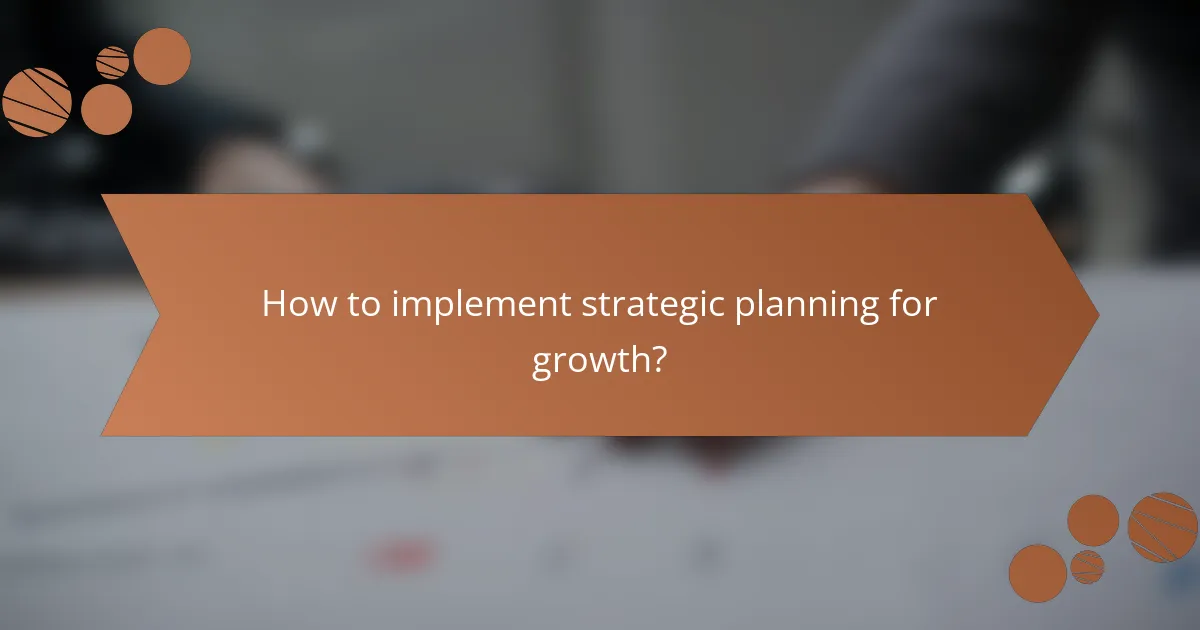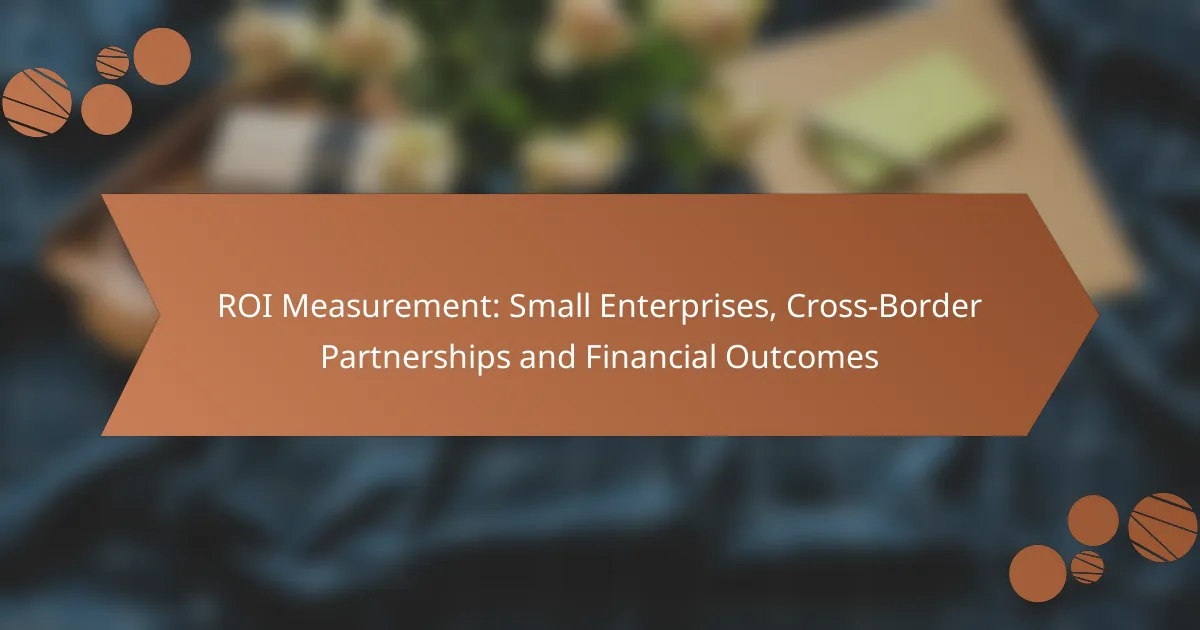Achievable goals are essential for success in e-commerce, as they provide a framework for defining clear and realistic objectives that align with your business strategy. By fostering effective cross-border partnerships through careful planning and communication, businesses can expand their international presence. Additionally, strategic planning enables organizations to analyze market conditions and align resources, ensuring they can navigate challenges and seize opportunities in a competitive landscape.

How to set achievable goals in e-commerce?
Setting achievable goals in e-commerce involves defining clear, realistic objectives that align with your business strategy. This process helps to ensure that your targets are not only ambitious but also attainable, allowing for effective tracking and adjustment as needed.
SMART goals framework
The SMART goals framework is a widely used method for setting effective objectives. Each goal should be Specific, Measurable, Achievable, Relevant, and Time-bound. For instance, instead of saying “increase sales,” a SMART goal would be “increase online sales by 20% over the next quarter.” This clarity helps in focusing efforts and resources effectively.
When crafting SMART goals, consider the specific outcomes you want to achieve and how they relate to your overall business strategy. Ensure that each goal is realistic and relevant to your current market conditions.
Measurable KPIs
Measurable Key Performance Indicators (KPIs) are essential for tracking progress towards your e-commerce goals. Common KPIs include conversion rates, average order value, and customer acquisition cost. These metrics allow you to quantify success and make data-driven decisions.
Establish a baseline for each KPI to understand your starting point and set realistic targets. Regularly review these metrics to identify trends and adjust your strategies accordingly. For example, if your conversion rate is below industry averages, it may indicate a need for website optimization.
Time-bound milestones
Time-bound milestones help create urgency and accountability in achieving your e-commerce goals. Setting deadlines for each goal encourages consistent progress and allows for timely evaluations. For example, you might set a milestone to launch a new marketing campaign within the next month.
Break down larger goals into smaller, manageable milestones to maintain momentum. This approach not only makes the overall objective less daunting but also provides opportunities for celebrating small wins along the way. Regularly assess your progress against these milestones to stay on track and make necessary adjustments.

What are effective strategies for cross-border partnerships?
Effective strategies for cross-border partnerships involve careful planning, clear communication, and a solid understanding of legal frameworks. By identifying suitable partners and establishing trust, businesses can create mutually beneficial relationships that enhance their international reach.
Identifying potential partners
To identify potential partners for cross-border collaborations, start by researching companies that complement your business goals. Look for organizations with a strong local presence and a good reputation in their market. Networking events, trade shows, and online platforms like LinkedIn can be valuable resources for finding suitable partners.
Consider conducting a SWOT analysis (Strengths, Weaknesses, Opportunities, Threats) for each potential partner to assess their fit with your strategic objectives. Aim for partners that share similar values and business ethics to ensure a smoother collaboration.
Legal considerations for international trade
Legal considerations are crucial in cross-border partnerships, as they vary significantly by country. Familiarize yourself with trade regulations, tariffs, and import/export laws relevant to your industry. Consulting with legal experts who specialize in international trade can help navigate these complexities.
Additionally, ensure compliance with local laws regarding contracts, intellectual property, and dispute resolution. Understanding the legal landscape can prevent costly misunderstandings and protect your business interests in foreign markets.
Building trust and communication
Building trust in cross-border partnerships requires open and consistent communication. Establish regular check-ins to discuss progress, address concerns, and share feedback. Utilizing technology such as video conferencing tools can facilitate real-time conversations, bridging the distance between partners.
Be transparent about expectations and responsibilities from the outset. This clarity helps to foster a collaborative environment and reduces the likelihood of conflicts. Consider cultural differences in communication styles and be adaptable to ensure effective interactions.

How to implement strategic planning for growth?
Implementing strategic planning for growth involves setting clear objectives, analyzing market conditions, and aligning resources effectively. This structured approach helps organizations identify opportunities and challenges, ensuring they can adapt and thrive in a competitive landscape.
Market analysis techniques
Market analysis techniques are essential for understanding the competitive landscape and identifying growth opportunities. Common methods include surveys, focus groups, and data analysis to assess customer preferences and market trends.
Utilizing tools like SWOT (Strengths, Weaknesses, Opportunities, Threats) analysis or PESTEL (Political, Economic, Social, Technological, Environmental, Legal) frameworks can provide deeper insights into market dynamics. Regularly reviewing these analyses helps businesses stay informed and responsive to changes.
SWOT analysis for e-commerce
SWOT analysis for e-commerce focuses on evaluating internal strengths and weaknesses alongside external opportunities and threats. Strengths might include a strong online presence or unique product offerings, while weaknesses could involve limited logistics capabilities.
Opportunities in e-commerce often arise from emerging market trends, such as increased mobile shopping or shifts in consumer behavior. Conversely, threats may include intense competition or regulatory changes affecting online sales. Regularly updating this analysis can guide strategic decisions effectively.
Resource allocation strategies
Resource allocation strategies are crucial for optimizing the use of financial, human, and technological resources to achieve growth objectives. Prioritizing projects based on potential ROI (Return on Investment) and aligning resources accordingly can enhance efficiency.
Consider implementing a balanced scorecard approach to track performance across various areas, ensuring that resources are directed toward initiatives that align with strategic goals. Avoid common pitfalls such as underfunding critical projects or overextending resources, which can hinder growth efforts.

What are the key performance indicators for success?
Key performance indicators (KPIs) for success are measurable values that demonstrate how effectively an organization is achieving its business objectives. They help assess performance in various areas, guiding decision-making and strategic planning.
Sales growth metrics
Sales growth metrics track the increase in revenue over a specific period, indicating the effectiveness of sales strategies. Common measures include year-over-year growth percentage and monthly sales growth rates. A typical target might be a growth rate of 10-20% annually, depending on the industry.
To effectively monitor sales growth, consider segmenting data by product line or region. This granularity can reveal trends and areas needing improvement. Regularly reviewing these metrics helps identify successful strategies and areas for adjustment.
Customer acquisition costs
Customer acquisition cost (CAC) measures the total cost of acquiring a new customer, including marketing and sales expenses. A lower CAC indicates more efficient customer acquisition strategies. A good benchmark is to aim for a CAC that is less than one-third of the customer’s lifetime value (CLV).
To optimize CAC, focus on targeted marketing campaigns and leverage data analytics to identify the most effective channels. Avoid overspending on broad advertising that does not yield high conversion rates, as this can inflate your CAC unnecessarily.
Return on investment
Return on investment (ROI) evaluates the profitability of an investment relative to its cost. It is calculated by dividing the net profit from an investment by the initial cost, expressed as a percentage. A positive ROI indicates that the investment is generating more income than it costs.
To maximize ROI, prioritize investments that align with your strategic goals and have a clear path to profitability. Regularly assess the performance of your investments and be prepared to pivot if certain initiatives do not meet expected returns. Aim for an ROI of at least 15-20% for most business investments to ensure sustainability.

How to evaluate the effectiveness of partnerships?
Evaluating the effectiveness of partnerships involves assessing their performance, gathering feedback, and conducting long-term relationship assessments. This process helps identify strengths and weaknesses, ensuring that partnerships align with strategic goals.
Performance reviews
Performance reviews are essential for measuring the success of partnerships. These evaluations typically focus on key performance indicators (KPIs) such as revenue growth, customer satisfaction, and project completion rates. Regular reviews, ideally quarterly or bi-annually, can help partners adjust strategies and improve outcomes.
Consider using a scoring system to rate performance across various metrics. This can help visualize progress and identify areas needing attention. For example, a partnership might aim for a 15% increase in sales within a year, which can be tracked through performance reviews.
Feedback mechanisms
Implementing feedback mechanisms is crucial for understanding partner satisfaction and areas for improvement. Surveys, interviews, and regular check-in meetings can provide valuable insights into each partner’s experience. Aim to gather feedback at least twice a year to keep communication open and proactive.
When designing feedback tools, focus on specific questions that address partnership goals. For instance, ask partners to rate their satisfaction with communication and support on a scale from 1 to 10. This quantitative data can complement qualitative insights, offering a comprehensive view of partnership health.
Long-term relationship assessments
Long-term relationship assessments evaluate the overall health and sustainability of partnerships. These assessments should consider factors such as trust, mutual benefits, and alignment of goals. Conduct these evaluations annually to ensure that the partnership remains relevant and beneficial for both parties.
During long-term assessments, analyze trends over time, such as changes in collaboration effectiveness or shifts in market conditions. This can help partners make informed decisions about continuing, expanding, or restructuring their relationship. Establishing a clear framework for these assessments can streamline the process and enhance outcomes.

What are the prerequisites for successful strategic planning?
Successful strategic planning requires a clear understanding of the market landscape, stakeholder needs, and organizational goals. These prerequisites ensure that the planning process is grounded in reality and aligned with both internal capabilities and external opportunities.
Market research requirements
Effective market research is essential for informed strategic planning. It involves gathering data on industry trends, customer preferences, and competitive dynamics. This information helps organizations identify opportunities and threats, allowing for more accurate forecasting and decision-making.
When conducting market research, consider using a mix of qualitative and quantitative methods. Surveys, focus groups, and industry reports can provide valuable insights. Aim to gather data that covers a range of perspectives to ensure a comprehensive understanding of the market.
Stakeholder engagement
Engaging stakeholders is critical for successful strategic planning. Stakeholders include employees, customers, partners, and investors, each bringing unique insights and perspectives. Involving them early in the process fosters buy-in and can lead to more effective strategies.
To effectively engage stakeholders, conduct regular meetings and solicit feedback through surveys or workshops. This approach not only enhances collaboration but also helps identify potential challenges and opportunities that may not be immediately apparent. Remember to communicate clearly and transparently to build trust and commitment among all parties involved.



